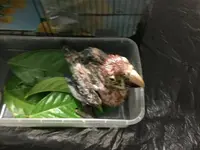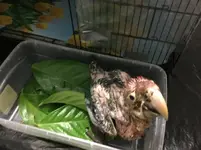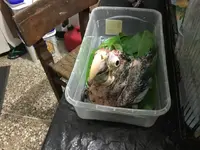Also this great info originally posted by EllenD
Since you've hand-fed other baby parrots before you probably have a better understanding/eduction than most people who come here asking these types of questions, but just to make sure and to save you from any serious issues, heartache, or tragedy that often happens when people take-on hand-feeding such a young baby parrot, I'm going to quickly run-down the most important and NON-OPTIONAL bullet-points that you must follow to a tee or your baby will become sick and suffer potentially fatal health problems:
#1.) The hand-feeding formula that you feed your baby Senegal must ALWAYS be between 104 degrees F and 110 degrees F, and must stay in that temperature range throughout the feeding. One degree colder and your baby can suffer fungal/yeast infections in their Crop and throughout their GI Tract, and this can cause Slow-Crop and Crop-Stasis. Even 1 degree hotter and it will cause burns on your bird's crop that usually cause severe infection and require surgery to remove the burnt portion of the Crop...So you must use a digital cooking/candy thermometer that has a metal probe you can place in the formula and keep in the formula throughout each hand-feeding. If the formula needs to be re-heated because it drops below 104 degrees F, do not microwave the already mixed formula because it will develop "hot pockets" that will burn your bird's Crop no matter how well you mix it; instead just microwave water or unflavored Pedialyte, whichever you're using to mix the formula, and then add it slowly to the already mixed formula...
#2.) At 3 weeks old your baby Senegal should have most of it's down feathers but very little to no outer feathers...I don't know if you have a real, proper Brooder that you are keeping your baby in, but if not then you need to at a minimum make a "homemade' Brooder that will keep the amibient temperature your baby is kept in within the correct temperature ranges...If the ambient temperature your baby bird is kept in is too cool they will develop the same fungal/yeast infections and problems as they do when the formula is too cold....If your baby bird does not yet have ALL of their down-feathers yet and still has bare skin exposed, then they MUST be kept in an ambient temperature between 90-95 degrees F at all times except for when you take them out for a hand-feeding or a short handling. Once all of their down feathers are in and there is no more bare skin exposed, but they still don't have all of their outer feathers grown in fully, their ambient temperature must always be between 75-80 degrees F. For a baby Senegal Parrot, who normally wean between the ages of 10 weeks old and 13 weeks old, they should be able to be transferred from their Brooder and into their first "Weaning" or "Starter" Cage around the age of 6-7 weeks old.
To Make a Handmade Brooder: All you need is a cardboard box that is large enough to have a front half and a back half with two different temperature zones, but not too large a box. You need an electric heating-pad that has an adjustible temperature, which will sit underneath the back-half of the box at all times. You'll also need an ambient thermometer that you can place/hang/stick in the back-half of the box, and this is what you will look at to make sure that the back-half of the box is always within the correct temperature range. Then you cover the back-half of the box with a towel or blanket to lock-in the heat in the back-half of the box, leaving the front half of the box uncovered and off of the heating-pad. Once you get this all set-up, turn on the heating-pad to low or medium and cover the back-half of the box, and wait for about 30 minutes for the temperature to reach it's max, and if it's not withint the correct temperature range then you turn it up a setting and wait another 30 minutes. Make sure you have a good, accurate ambient thermometer, the best and cheapest ones being the Accurite digital thermometers that you can just sit in the back of the box and that you can buy at any Walmart, Lowes, Home Depot, etc. for around $10-$15 (same for the digital cooking/candy thermometer with the metal probe, Walmart sells them for around $15 in the cooking gadget section)...Leave the front half of the box uncovered and off of the heating-pad so that your baby bird can go to the front of the box if they get too warm...Once your baby is around 6 weeks old or so, or when he/she has all of their outer feathers grow-in and no down-feathers are exposed, then you can move your bird into their Weaning/Starter Cage.
#3.) As far as the hand-feedings go, at only 3 weeks old your baby Senegal MUST be fed every 2-3 hours INCLUDING OVERNIGHT! They cannot go 6-8 hours overnight without being fed every 2-3 hours until they are between 4-5 weeks old. So you unfortuantely have to set an alarm for every 2 hours and get up every 2 hours, check his/her crop, and if it's just about empty at 2 hours then that's the interval that you'll feed them at for the next week. If his/her crop is not almost empty at 2 hours, then check it again at 3 hours and it should be almost empty, and that will be your feeding interval...
During the daytime and during the night until he/she is at least 4 weeks old (before they can go a full 6-8 hours overnight without being fed), their Crop should be almost empty when you give them their next hand=feeding, but won't be completely empty. The only time their Crop will be completely empty between feedings will be at their first morning feeding at 4 weeks, when they can go a full 6-8 hours without being fed...At only 3 weeks old they cannot go any longer than 3 hours maximum without being fed 24 hours a day, and that's why their Crop will never be completely empty at any time of a hand-feeding...Again, at 4 weeks old he/she will be able to go overnight for 6 hours or so without a hand-feeding, and their Crop will be completely empty first thing in the morning when you give them their first hand-feeding of the day; otherwise, during the rest of the day their Crop will be almost empty between hand-feedings, but not quite.
As far as how much formula you should give them during each hand-feeding, I never really go by a "set amount" based on their age as some breeders do...I always go by the size and feeling of their Crop, which you need to always be looking at and feeling lightily with the pad of your finger. At the end of all hand-feedings, their Crop should look very large and round, and when you feel it very gently with your finger (don't ever push on the Crop, just lightly run your finger over it), it should feel like a very full balloon that still has a little bit of 'give" to it. It should not feel tight, if it does then you are feeding them too much formula. And you cannot expect them to stop their feeding-response at the correct time; usually they do actually stop eating and stop their feeding-response and start rejecting the syringe close to the correct time, but not necessarily...YOU CAN NEVER, EVER TRY TO FORCE MORE FORMULA INTO THEM, WHEN THEY'RE DONE THEY'RE DONE, BUT YOU CAN STOP GIVING THEM ANY MORE FORMULA BEFORE THEIR FEEDING-RESPONSE STOPS AND BEFORE THEY THINK THEY ARE DONE, BASED ON THE SIZE AND FEEL OF THEIR CROP.
It's extremely important that you fully "Abundance-Wean" your Senegal, which means that you allow HIM/HER to make the decision when a hand-feeding is removed, and when the amount of formula in each hand-feeding is reduced. If YOU make the decision to remove a hand-feeding each day, or to reduce the amount of formula in each hand-feeding, this is called "Force-Weaning" your baby bird, and it usually results in severe, life-long Neurological and Behavioral issues, as well as serious and sometimes life-threatening physical medical problems...So allow your bird to tell you when a feeding will be rejected or the amount of formula per feeding will be reduced.
Typically the amount of formula they eat per hand-feeding and the number of hand-feedings per day will stay the same until a Senegal Parrot is between 5-6 weeks old, at which time he'll start eating more and more solid food, thus eating less formula. I would typically start putting millet-sprays inside of the Brooder at the age of 4 weeks-old, so that they start learning what solid-food is and will start picking at it and eventually eating it. At 5 weeks old I place a bowl of either pellets of seeds, whichever you are planning on weaning him onto as his daily "staple" food, inside of the Brooder, and once they start eating a good amount of the pellets or seed-mix (or both if you like), then they'll start to Abundance-Wean themselves. At the point where you move them into their Weaning/Starter Cage (when their outer feathers grow-in and no down-feathers are exposed, around 6 weeks old or so), then you're going to also start giving them a bowl of fresh Veggies, dark leaafy Greens, and a very small portion of Fruit every day as well, so that they'll learn what they are and to eat them.
Eventually you'll get to the point that they'll be eating a hand-feeding first thing in the morning and just before bed, and they'll be eating their pellets/seed-mix and fresh Veggies and Greens throughout the day...Then around the time they fully-Fledge, they'll eliminate the morning hand-feeding, and will basically be fully Abundance-Weaned, for a Senegal this will happen between 11-13 weeks old. They will typically continue to beg for a hand-feeding at night just before bed even after they are fully Abundance-Weaned, and this is called a "Comfort-Feeding", and it can continue for a week or two after they actually fully-wean. This is normal, it's not that they're hungry, it's just a comfort thing...
__________________
May your joy be as deep as the ocean, and your sorrows as light as the foam.
Last edited by Laurasea; 01-04-2020 at 10:12 PM.
Reply With Quote Multi-Quote This Message Quick reply to this message



